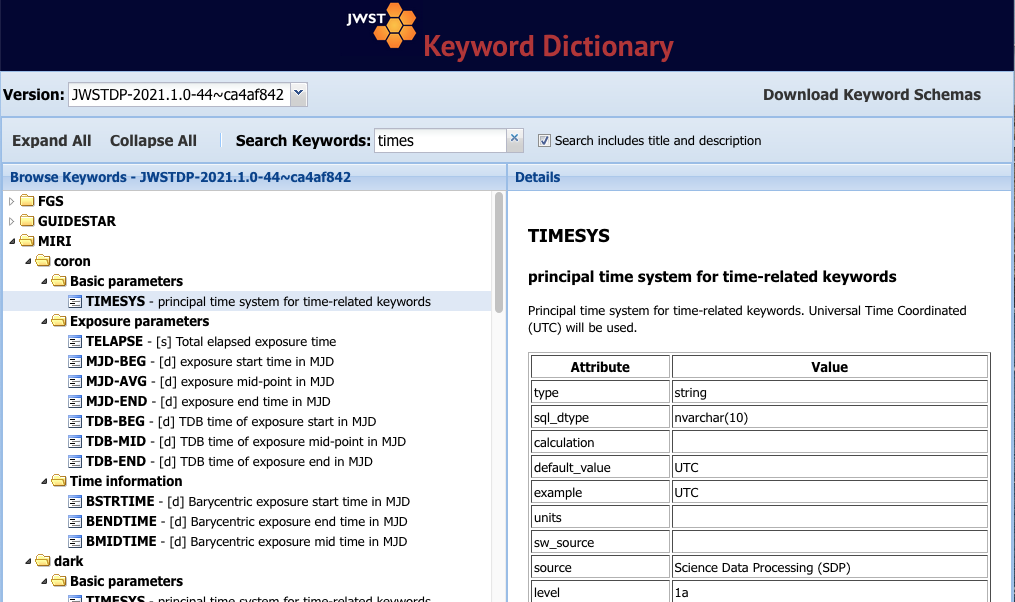This article will help you identify and interpret header metadata within JWST data products in FITS format.
On this page...
Science Metadata
Metadata in FITS-formatted Science data products are stored as keyword records in the file header(s). Each record consists of a name, a value, and an optional comment. The keyword name of up to 8 alpha-numeric characters in length is intended to be descriptive of the associated quantity. There are hundreds of keywords, some of which are broadly applicable to data from all JWST instruments, some are specific to a particular instrument; others still are in common with more than one instrument, but not all.
Metadata that appear in science products in any other format than FITS are not described in the Keyword Dictionary. See the section Data Product Formats in the article Science Data Products for examples of non-FITS data products.
Keyword Dictionary
Each keyword has a formal definition in the JWST Keyword Dictionary. The Dictionary is a web-based form that enables you to find the instrument(s) and configuration(s) to which a keyword applies, as well as the description of the keyword, as shown in the figure below.
The JWST Keyword Dictionary interface, which has panels to navigate an instrument/configuration (left), and detailed descriptions of individual keywords (right). Text entered in the search box (top, center) will dynamically match keyword names and, optionally, descriptions.
To understand which keywords apply to which instruments and configurations (e.g., imaging, spectroscopy, or coronagraphy), use the navigation tree in the left-hand panel. To locate a keyword by name, begin typing in the Search Keywords dialog box. Keyword names will be minimum-matched, and are case-insensitive. Tick the box next to the dialog to also match terms in the keyword descriptions. Click a keyword entry in the navigation tree to see its description in the right-hand panel. Note that keywords by the same name in the headers of different products have exactly the same definition.
Keywords in JWST headers adhere to the FITS Standard v4.0. The keyword descriptions are very detailed, and include information on the datatype of the value, the format, the physical units (if applicable), the instrument(s) and configurations to which the keyword applies, and the source of the information (or the calculation) from which the value was determined. It also indicates whether the keyword will be found in the file primary header, or in one or more FITS extension headers.
Keyword records located in the primary FITS header, such as TIMESYS (the default time system), are understood to apply to all data in all extensions within the file. Keyword records located in extension headers apply only to data within that extension. Most keywords that define the World Coordinate System (WCS) are located in extension headers.
Metadata Categories
The Keyword Dictionary metadata are organized by categories of related items, regardless of where they appear in the headers. A subset of important categories of keywords are highlighted in the following table; see the Keyword Dictionary for the complete set of categories.
| Category | Keywords Included |
|---|---|
| Basic |
|
| Observation |
|
| Target |
|
| Exposure |
|
| Calibration & Reference File Information |
|
| Photometry |
|
| World Coordinate System |
|
For Further Reading...
- JWST Keyword Dictionary search form
- JWST Science Data Product Types
